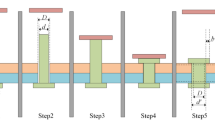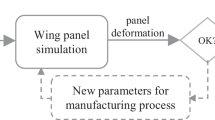Abstract
Slug rivet interference-fit riveting is one of the advanced connection technologies, which has been widely applied in aerospace manufacture. In the fields of residual stress analysis, structural deformation analysis, load transfer mechanism analysis, and the assessment of the effects of process parameters on riveting quality, study accuracy needs increasingly accurate and comprehensive models. Since the simulation of riveting process is a particularly time-consuming case. The aim of this paper is to develop some appropriate FE models for the special applications with a compromise between model size, calculation time, and simulation precision. Different types of FE models have been established based on force-controlled approach and displacement-controlled approach. The comparison between different FE models is satisfactory in terms of riveting process and riveting quality control criterion. The study significantly deepens the comprehension of the slug rivet installation process. Subsequent research can select an appropriate model according to its special target. The study will pave the way for further investigations.
Similar content being viewed by others
References
Liang C (2011) Survey report of aircraft automatic assembly technology and equipment application. Aeronautical Manufacturing Technology 19:54–55
Rooks B (2013) Automatic wing box assembly developments. Ind Robot 28(4):297–302
Holden R, Haworth P, Kendrick I, Smith A (2007) Automated riveting cell for a320 wing panels with improved throughput and reliability (sa2)
Sarh B et al (2009) Aircraft manufacturing and assembly. In: Springer handbook of automation. Springer Berlin Heidelberg
Liu G, Huan HL, Ke YL (2014) Study on analysis and prediction of riveting assembly variation of aircraft fuselage panel. Int J Adv Manuf Technol 75(5–8):991–1003
Aman F, Cheraghi SH, Krishnan KK, Lankarani H (2013) Study of the impact of riveting sequence, rivet pitch, and gap between sheets on the quality of riveted lap joints using finite element method. Int J Adv Manuf Technol 67(1–4):545–562
Cheraghi SH (2008) Effect of variations in the riveting process on the quality of riveted joints. Int J Adv Manuf Technol 39(11–12):1144–1155
Zeng C, Liao WH, Tian W (2015) Influence of initial fit tolerance and squeeze force on the residual stress in a riveted lap joint. Int J Adv Manuf Technol 81(9–12):1643–1656
Li YJ (1998) An analysis of riveting process by theoretical, nonlinear finite element and experimental methods. PhD Thesis, Wichita State University, Wichita
Mu WQ et al (2010) An effective method of studying interference-fit riveting for 2117-T4 aluminum slug rivet. International Conference on Computer and Communication Technologies in Agriculture Engineering, pp. 303–307
Mu WQ et al (2010) Mathematical modeling for and simulation analysis of flush rivet pressing force. J Northwest Polytech Univ 28(5):742–747
Song DL et al (2012) An effective mathematical modeling for and simulation analysis of flush rivet pressing force of CFRP / AI components. J Northwest Polytech Univ 30(4):558–564
Shishkin SS (2010) Computation of the contact load in a rivet bond. J Mach Manuf Reliab 39(1):43–46
Lei CY et al (2017) Effect of riveting parameters on the quality of riveted aircraft structures with slug rivet. Adv Mech Eng 9(11):1–12
Liu LX et al (2013) Semi-empirical research on automatic drilling and riveting process of headless rivet. J Northwest Polytech Univ 31(1):77–82
Chang Z et al (2016) Investigation of riveting parameters influence on the riveted joints deformation during slug rivet installation. ASME 2016 International Mechanical Engineering Congress and Exposition V002T02A027
Wang ZQ et al (2017) Optimization of riveting parameters using Kriging and particle swarm optimization to improve deformation homogeneity in aircraft assembly. Adv Mech Eng 9(8):1–13
Reinhall PG, Ghassaei S, Choo V (1988) An analysis of rivet die design in electromagnetic riveting. J Vib Acoust Stress Reliab Des 110:65–69
Repetto EA, Radovitzky R, Ortiz M, Lundquist RC, Sandstrom DR (1999) A finite element study of electromagnetic riveting. J Manuf Sci Eng 121:61–68
Gasser F et al (2015) Numerical and experimental investigation of aircraft panel deformations during riveting process. J Manuf Sci Eng 137:1–11
Shanghai Aircraft Manufacturing Company (2010) Rivet Criterion ZPS-XXX
Müller RPG (1995) An experimental and analytical investigation on the fatigue behavior of fuselage riveted lap joints. The significance of the rivet squeeze force, and a comparison of 2024-T3 and Glare 3. Doctor thesis, Delft University of Technology
Szolwinski MP, Farris TN (2000) Linking riveting process parameters to the fatigue performance of riveted aircraft structures. J Aircr 37(1):130–137
Atre A (2006) A finite element and experimental investigation on the fatigue of riveted lap joints in aircraft applications. PhD Thesis, Georgia Institute of Technology, Atlanta, Georgia
Li G, Shi G, Bellinger NC (2006) Studies of residual stress in single-row countersunk riveted lap joints. J Aircr 43(3):592–599
Blanchot V, Daidie A (2006) Riveted assembly modelling: study and numerical characterisation of a riveting process. J Mater Process Technol 180(1):201–209
Author information
Authors and Affiliations
Corresponding author
Additional information
The work described in this paper has been supported by grants from the National Natural Science Foundation of China (No. 51775495), Science Fund for Creative Research Groups of National Natural Science Foundation of China (No. 51521064), and Youth Funds of the State Key Laboratory of Fluid Power and Mechatronic Systems (Zhejiang University)(SKLoFP_QN_1802).
Rights and permissions
About this article
Cite this article
Lei, C., Bi, Y., Li, J. et al. Experiment and numerical simulations of a slug rivet installation process based on different modeling methods. Int J Adv Manuf Technol 97, 1481–1496 (2018). https://doi.org/10.1007/s00170-018-1990-1
Received:
Accepted:
Published:
Issue Date:
DOI: https://doi.org/10.1007/s00170-018-1990-1




